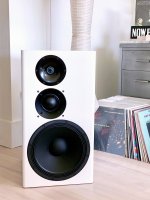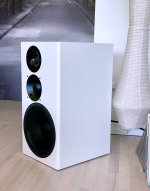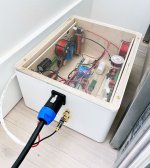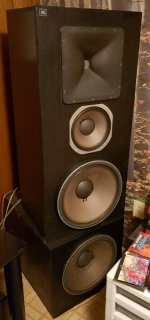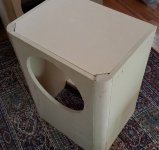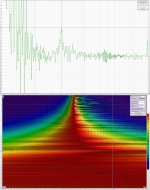Zoooooom! The sound of things going over my head while breaking the sound barrier! 😛 Actually, I understand the above.
Wanted to update ... Two people offered me designs I'm going to build. I'll update when I decide on xover components, and get some BB plywood shipped in.
I thank everyone, and am still learning like crazy from this thread. I understand some don't like it. But it is hard to argue with something really educational to someone.
Wanted to update ... Two people offered me designs I'm going to build. I'll update when I decide on xover components, and get some BB plywood shipped in.
I thank everyone, and am still learning like crazy from this thread. I understand some don't like it. But it is hard to argue with something really educational to someone.

Down below, the room dominates is what you are saying...but does it really? Isnt it all a matter of what your direct sound to room sound ratio maybe? Time to peak energy is a no brainer...if the signal lags (too far) behind the rest of the signal, its not desirable.
Is there a specific link to that information you spoke of?
No my friend! Nearfield is in no way a cure for what happen below Schroeder freq. It can be above but not below.
Simple experiment: find a room mode in your room, locate your sweetspot nearfield at that room mode, listen if it disapeared or not ( keep in mind that the location of the Loudspeakers will probably change the way the room is excited but if you are on a mode... you are on a mode! 😉 ).
When i say dominate in the couple i really mean it! Next time you go to a dungeon, try to see if your domina is really dominating!! LOL
It may not be a good example as we know this is the slave which drive it all in the dungeon but... you get the idea! (Whiplash sound)! LOL.
I forgot another answer for low end ( acoustic and or dsp): multi sub.
Most advanced people know it but it may not be obvious to others. 😉
Flaxxer, this is the right time to ask if it is educational! Even if you don't get what is answered it'll give you some clues of what to search.
And there is no stupid question, only bad answers! 😉
Last edited:
I dont think you building someone else's design is an issue...I personally was just trying to guide you to your goal with the best bang for your buck.
I think I could build a "good enough" version of my style design for 2500, essentially a compression driver crossed to a 15" around 4-500hz and then an 18" under that. TMM 2.5 way...not counting dsp and maybe some of building material.
The geddes speaker is a 15" crossed to a compression driver...the strauss mf 2.1 is a 15" crossed to a compression driver....jbl m2 is a 15" crossed to a compression driver... the altecs 2ways are famous for a 15" crossed to...a compression driver..it's not that they want to copy each other... sometimes when "the best available" is this "one thing"....it's what you use.
The thing I was trying to convey to you is that, "the best configuration" is Not so because of some fancy driver, actually if you can afford that part, its really icing on the cake...this "best" configuration I speak of is a result of efficiency and low driver count....not so much, alien technology within a driver. Off axis is a matter of enclosure and horn/waveguide design, also fueled by good physics theory and not so much throwing money at it
I think I could build a "good enough" version of my style design for 2500, essentially a compression driver crossed to a 15" around 4-500hz and then an 18" under that. TMM 2.5 way...not counting dsp and maybe some of building material.
The geddes speaker is a 15" crossed to a compression driver...the strauss mf 2.1 is a 15" crossed to a compression driver....jbl m2 is a 15" crossed to a compression driver... the altecs 2ways are famous for a 15" crossed to...a compression driver..it's not that they want to copy each other... sometimes when "the best available" is this "one thing"....it's what you use.
The thing I was trying to convey to you is that, "the best configuration" is Not so because of some fancy driver, actually if you can afford that part, its really icing on the cake...this "best" configuration I speak of is a result of efficiency and low driver count....not so much, alien technology within a driver. Off axis is a matter of enclosure and horn/waveguide design, also fueled by good physics theory and not so much throwing money at it
Last edited:
No my friend! Nearfield is in no way a cure for what happen below Schroeder freq. It can be above but not below.
Simple experiment: find a room mode in your room, locate your sweetspot nearfield at that room mode, listen if it disapeared or not ( keep in mind that the location of the Loudspeakers will probably change the way the room is excited but if you are on a mode... you are on a mode! 😉 ).
I always leave myself an out by stating the things that I am not 100% on, in the form of a question… Thanks for providing the wisdom 😀
It is an integral. What driver has better Vd, the aforementioned Faitalpro 15 or a Seas L26ROY? Also, Vd is often determined by measuring distortion, not by calculating (VC height - pole plate height)/2.Derivative =2 : having parts that originate from another source
Vd = This parameter is the Peak Diaphragm Displacement Volume — in other words the volume of air the cone will move. It is calculated by multipying Xmax (Voice Coil Overhang of the driver) by Sd (Surface area of the cone). Vd is noted in cc.
The aforementioned Faitalpro shows slight signs of resonance at 150Hz when you examine response and impedance plot.Well, I never intended for my 15" to ever play that high but they say Acoustic Elegance drivers can??? Please show me a good reason to run a 15" past 8-900 since we normally do not run a driver into beaming territory
It’s not me, it’s you who poses that group delay matters and that you can measure it. I just questioned your findings. I don’t know of research that seems to backen your claims.Down below, the room dominates is what you are saying...but does it really? Isnt it all a matter of what your direct sound to room sound ratio maybe? Time to peak energy is a no brainer...if the signal lags (too far) behind the rest of the signal, its not desirable.
Is there a specific link to that information you spoke of?
I dont think you building someone else's design is an issue...I personally was just trying to guide you to your goal with the best bang for your buck.
.it's not that they want to copy each other... sometimes when "the best available" is this "one thing"....it's what you use.
The thing I was trying to convey to you is that, "the best configuration" is Not so because of some fancy driver, actually if you can afford that part, its really icing on the cake...this "best" configuration I speak of is a result of efficiency and low driver count....not so much, alien technology within a driver. Off axis is a matter of enclosure and horn/waveguide design, also fueled by good physics theory and not so much throwing money at it
You will be glad to know one of the designs is a two way ... Large horn to a 15" driver. The other forum member has been away from the forum a few days. But his design is similar, yet uses a midrange driver.
Much of this convo is way beyond my current knowledge—And I certainly don't need to sell anyone on anything... but regarding Matthias's OSMB (C!) project—I can't see a scenario where they wouldn't get loud enough for regular use—this comment regarding all the talk about efficiency/sensitivity. I have plugged many power amps and pre amp combos into them—as low as 8wpc—without question the music will get loud enough that one can't be in the room (12 x 24' with 16' ceiling peak) and still sounds fantastic outside the house (doors open). I can't see a reason for a more "sensitive" speaker—but I'm certain there's a lot I am missing. And—as I mentioned earlier—and I saw Matthias chime in on—They cost me well under $3k to build—but I have woodworking skills. Some images here—since this thread is light on the pictures. I also have limited positioning options given the room. My only regret about building my last speaker first 😀 is that I really want to build them again.
Attachments
You will be glad to know one of the designs is a two way ... Large horn to a 15" driver. The other forum member has been away from the forum a few days. But his design is similar, yet uses a midrange driver.
A well executed 15" and CD combo is really hard to beat. Camplo did a good job on the history. This is where the original design came from. The Lansing Iconic from 1937. Some of these are still around and I would love to hear one.
I have a passive DIY 15" and 4" CD that I really enjoy, also have a DIY 4 active set up based around a 15" woofer but using 10" mid. So either way it's possible to get great results.
Rob🙂
ICONIC
@Robh3606 ... I'm excited to test the theory, lol.
You've done something I'm still interested in ... a 10" mid. I'd love to combine a 10" mid with my Kappalites and a good highs transducer! I'm considering this active with DSP. I have a pair of 10" mids. Need to see if they work well in this scenario, then choose my highs.
You've done something I'm still interested in ... a 10" mid. I'd love to combine a 10" mid with my Kappalites and a good highs transducer! I'm considering this active with DSP. I have a pair of 10" mids. Need to see if they work well in this scenario, then choose my highs.
Last edited:
Do these specs tell us anything without measurements?
- treated paper cone, rubber surround
- Cast aluminum frame
- Size: 10.625"
- Cut-out: 9.375"
- Depth: 4.5"
- Voice coil: 1.5"
- Magnet: 35 oz
- Impedance: 4 ohms, Re: 3.4 ohms
- Power: 80 watts RMS, 160 watts max
- Sensitivity: 94.6 dB, 1 watt, 1 meter
- Le: 1.2 mH, Fs: 27 Hz, Vas: 1.75 cu. ft., Qms: 4.1, Qes: .54, Qts: .48, Xmax: 4mm
I'm not sure where camplo gets his definition of efficiency but the dictionary definition is "the ratio of the useful work performed by a machine or in a process to the total energy expended or heat taken in.". Excursion is only part of a part of the power equation. Efficiency is a ratio of two energy/power values. The acoustic power varies as the product of the excursion and the piston (cone) size and the frequency, and...
Ya want transparency ??? Okay, I'll give it to ya! Accountability too! LOL
I heard a pair of Forte IVs do some great things, most speakers don't do. But I heard things I could not live with also. So I went on a search for something I could not define ... many have tried here, and many have disagreed. What I know, is there is something about high WTF it is, that sounds "different" ... Why is still being debated today, lol.
I heard a pair of Forte IVs do some great things, most speakers don't do. But I heard things I could not live with also. So I went on a search for something I could not define ... many have tried here, and many have disagreed. What I know, is there is something about high WTF it is, that sounds "different" ... Why is still being debated today, lol.
@Robh3606 ... I'm excited to test the theory, lol.
You've done something I'm still interested in ... a 10" mid. I'd love to combine a 10" mid with my Kappalites and a good highs transducer! I'm considering this active with DSP. I have a pair of 10" mids. Need to see if they work well in this scenario, then choose my highs.
Hello Flaxxer
I built those over 20 years ago and except for an occasional driver update they have remained essentially the same concept. Here's a snap shot they are all JBL drivers an E-145 15" 2123 10" mid and 2453 CD on a PTH1010. Subs under.
This is an all analog active set-up with a passive CD horn compensation. You should have no issues using DSP and can correct for the horn CD curve with the DSP.
.5 cubic ft. sub-enclosure on the 10' 2123 crossed at 300 and 1.5K 24db L/R
If I built them today I would use the corner rounds to help reduce diffraction. They are easy to use and make really stiff corners. They are made of MDF material so you can paint them or venire over them. They are set up match up to 3/4 panel thickness.
Attachments
Last edited:
It is truly impressive when you have little or no desire to change over a 20yr period.
I have a pair of tens which are normally crossed over at 2400hz. I have the specs for the driver, but not the measurements. I will get those done as I learn.
As I've said, I'd love to pair them with the Kapplite 12's I own. Fun future plans.
I am possibly crazy, but I'm thinking of using these in a strange room I have. I may be insane, but I am very tempted to use the G1 ribbon in this design.
Of course, I may learn this is not feasible as I learn.😀
I mean, I will already have a speaker with 15" + Horn.
I have a pair of tens which are normally crossed over at 2400hz. I have the specs for the driver, but not the measurements. I will get those done as I learn.
As I've said, I'd love to pair them with the Kapplite 12's I own. Fun future plans.
I am possibly crazy, but I'm thinking of using these in a strange room I have. I may be insane, but I am very tempted to use the G1 ribbon in this design.
Of course, I may learn this is not feasible as I learn.😀
I mean, I will already have a speaker with 15" + Horn.
Group delay chart on topCamplo could you point to time to peak energy/ gd curves in your thread please i missed that.
CSD on the bottom, dotted line charts the time to peak energy
This is from my horn combo at 1 meter. There is a group delay reading for the lower register but its not from a woofer so I'm not sure how you want to take it. My point is that the time to peak energy expression follows group delay...thus it needs to be respected non the less.
Attachments
Last edited:
It is truly impressive when you have little or no desire to change over a 20yr period.
I have a pair of tens which are normally crossed over at 2400hz. I have the specs for the driver, but not the measurements. I will get those done as I learn.
As I've said, I'd love to pair them with the Kapplite 12's I own. Fun future plans.
I am possibly crazy, but I'm thinking of using these in a strange room I have. I may be insane, but I am very tempted to use the G1 ribbon in this design.
Of course, I may learn this is not feasible as I learn.😀
I mean, I will already have a speaker with 15" + Horn.
In fitting with all the other large format pro speakers, if you use a 10" midrange then you need to use a 10" waveguide/horn and compression driver, crossed over to get a directivity match between the two, so at about 1500Hz. Not with something daft like a ribbon.
The Klipsch Forte tweeters are garbage as is the crossover, hence the nasty sound in the higher frequencies. You don't need a ribbon to fix the problems of such a speaker, you just need a good design and good quality components.
Hello Camplo
What is the time scale?? 350Hz peak us Ms??
Rob 🙂
Dear Rob
2.46ms at 350hz on the CSD?
4.48ms at 350hz on the GD?
The translation isn't 1:1 but the trend is identical
It is an integral. What driver has better Vd, the aforementioned Faitalpro 15 or a Seas L26ROY? Also, Vd is often determined by measuring distortion, not by calculating (VC height - pole plate height)/2.
It’s not me, it’s you who poses that group delay matters and that you can measure it. I just questioned your findings. I don’t know of research that seems to backen your claims.
Check the above I guess, regarding group delay. Whether its direct energy or the room, it still matters non the less. Just like spectral decay, compliance (Q) and FR below the Schroeder....the source factors still remains and the result is the integral =)
- Home
- Loudspeakers
- Multi-Way
- I'm building a $4000 speaker kit ... Which one?
